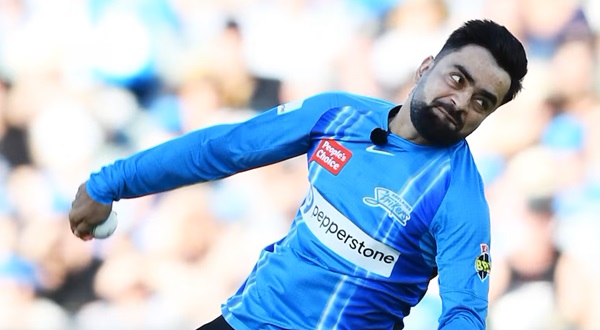
Spin Control
While there's no shortage of differences between baseball and cricket, there is some common ground. If you've watched any baseball, it's very easy to wrap your brain around the idea of a fast cricket bowler bringing the heat and coming in high and inside to a batter. But where the gears start to grind is when a spin bowler comes in and starts to seemingly lob the ball at the batter at 45 mph. And where the gears stop working entirely is when you see how effective this type of bowling actually is.
"We've always been labeled as the clever boys of cricket, because we have to outthink the batter," says Dane Piedt, who spent last year with Major League Cricket's Washington Freedom and -- more recently -- rekindled his international career with the South Africa Test team by taking an amazing eight-wicket haul against New Zealand in February. "We can't run in and just bowl a bouncer like the fast bowler. We actually have to try and spin the ball to get guys out."
And don't let the lack of a long, high-speed run-up fool you, spin bowling is intense. "What a lot of people don't understand is the amount of effort that a spin bowler puts on their body," stresses Piedt. "When a fast bowler runs up and bowls, you see the effort and the force a fast bowler exerts on their body. From a spinner's point of view, you don't really see it because the run-up is kind of timid. It's not as aggressive as a fast bowler. But if you see the best spinners in the world bowl, the energy they use at the crease is a lot greater than what people actually see."

The goal of the spin bowler is to bounce the ball close to the feet of the batter, giving him a split-second to decide which direction -- and to what degree -- the ball will spin after it hits the pitch.
The importance of spin bowling has ebbed and flowed throughout cricket history but, ironically, it was the emergence of T20 that's shown how dominating it can be. When the shortest version of the game was in its early phases, it was assumed that spinners would get eaten up by hitters swinging for the fences on each ball. But -- physics being physics -- the opposite occurred. A ball bowled at 50 mph doesn't fly off the bat nearly as far as a ball coming in at 90 mph. Spin bowling now accounts for roughly 40 percent of all balls bowled in T20s. And for the first time, spin bowlers are opening the bowling for teams -- something that was never really considered a viable strategy in the past.
There are two primary types of spin bowlers -- off-spinners and leg-spinners. (And for consistency, things here will be describing a right-handed bowler delivering the ball to a right-handed batter.) Off-spinners -- also called "finger spinners" -- deliver the ball with a clockwise spin that is designed to break left to right from off-stump to leg-stump after it bounces. This means it cuts in towards a right-handed batter. Leg-spinners -- also called "wrist spinners" -- put a counterclockwise spin on the ball that cuts right to left from leg-stump to off-stump after it bounces, making it bounce from inside to outside -- or away from -- a right-handed batter.
And here's where things get interesting. From a mechanical point of view, the difference between the two types of spin bowling is based on human physiology and the rule requiring the ball to be bowled with an essentially straight arm.
Reach out in front of you with a very straight right arm and pretend to turn a doorknob to the right (or clockwise). You should be able to do it relatively easily without your elbow bending. Now, try turning that imaginary doorknob to the left (or counterclockwise). If you're like the majority of humans on the planet, at some point in this counterclockwise turn, your elbow will bend. That's just the way we're built. External, clockwise rotation will straighten the arm, while internal, counterclockwise rotation will bend the arm. And bowling a ball with a bent elbow is, well, not cricket.
Essentially, due to the mechanics of the human body, to bowl a ball that bounces from leg-stump to off-stump to a right-handed batter, the spin and ball rotation must be created somewhere else.
Reach out in front of you again, but this time flex your wrist to ninety degrees. While this isn't the most normal of human positions, with the wrist cocked like this, you should now be able to turn your hand counterclockwise without your elbow bending. This is wrist spin and it's the contortionist-like movement that leg spinners have to perform to get the ball to move.

And that's just to get the ball to spin in a traditional way. The best in the game can get the ball to spin in either direction without much of a noticeable tell in their delivery. This makes spin even more lethal to the batter, but, of course, brings in an even greater amount of finger, wrist, and shoulder gymnastics.
For finger spinners, the "Doosra" (meaning "other one" in Hindi-Urdu) bounces away from a right-handed batter -- like leg spin -- but it's incredibly difficult ball to bowl and many who bowl doosras have had the legality of their deliveries questioned. A more common delivery, the "carrom ball", also gets the ball to act like leg spin. The ball is delivered with a flick of the middle finger by the bowler -- a movement similar to the way players move the plastic discs around the board in the popular South Asian game, carrom. For leg spinners, the "googly" is the delivery that cuts in on a batter, like traditional finger spin. Piedt isn't slipping into hyperbole when he says: "Spin bowling is probably the most unnatural thing to do in sports."
Dane developed his carrom ball in 2014 to add another weapon and more variety to his arsenal of deliveries. "I'll try to bowl the carrom ball to a right hander because they set up to play the ball to the leg side. The variation is basically to keep the batter honest, to let them know that I'm not that predictable and I'm not just bowling the same delivery just to let you play the kind of shot that you want to play.
"Cricket is a big 'feel' game. And that's what I can relate to with baseball. The catcher and the pitcher -- they sort of feel what the batter is trying to do. And that's why the communication between the two is so important. So that's what I relate to. If I'm feeling that the batter is going to be playing a certain way, why don't we try this? Why don't we go slightly wider? Why don't we come slightly closer to bring in a mistake from the batter? We're waiting for that small mistake from the batter in order to break through and get a wicket."
Unlike baseball, where weather and humidity are the primary environmental factors to look at, in cricket, because the ball is delivered on a bounce, the quality and make-up of the pitch also has to be considered. "Growing up in South Africa, pitches tend to bounce a lot more than any other part of the world. Australia bounces. South Africa bounces. New Zealand, to a certain extent, bounces a little bit. When you go to the subcontinent, it's completely different because the lack of bounce is something that makes it easier for the batter. So, you have to try and look for variation of pace and variation of spin. You need to be able to read the conditions to be like, 'Okay, this is what I'm gonna bowl today.'"


Dane won't be a part of Major League Cricket this year as he'll be playing at the international level with the South Africa Test team. (He will be representing the Morrisville Raptors in Minor League Cricket, though.) That said, there'll be no shortage of amazing spin coming to the US this summer, as two of the game's top practitioners will be returning for the second season of Major League Cricket starting in July. MI New York's Rashid Khan is currently the top leg spinner in the world, while the LA Knight Riders' Sunil Narine continues to reinvent himself as one of the most creative spinners in history.
© CricAmerica.com/Steve Steinberg 2024
Incredibly cool Dane Piedt/Morrisville Raptors card courtesy of Mark Mosely




